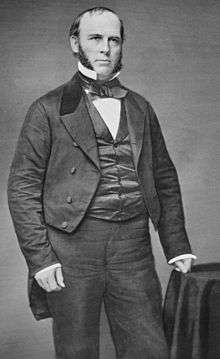Charles Durkee
Charles H. Durkee (December 10, 1805 – January 14, 1870) was an American politician, Congressman and Senator from Wisconsin.
Charles Durkee | |
|---|---|
 | |
| Governor of Utah Territory | |
| In office September 30, 1865 – January 9, 1869 | |
| Preceded by | James Duane Doty |
| Succeeded by | John Shaffer |
| United States senator from Wisconsin | |
| In office March 4, 1855 – March 3, 1861 | |
| Preceded by | Isaac Walker |
| Succeeded by | Timothy Howe |
| Member of the U.S. House of Representatives from Wisconsin's 1st district | |
| In office March 4, 1849 – March 3, 1853 | |
| Preceded by | William P. Lynde |
| Succeeded by | Daniel Wells, Jr. |
| Personal details | |
| Born | December 10, 1805 Royalton, Vermont |
| Died | January 14, 1870 (aged 64) Omaha, Nebraska |
| Nationality | American |
| Political party | Free-soiler, later Republican |
Early life
Durkee was born in Royalton, Vermont. He became a merchant and moved to Wisconsin in 1836. There he became involved in agriculture and lumbering, and was a founder of the town of Southport (later Kenosha, Wisconsin). Land he once owned in Kenosha is now part of the Library Park Historic District.[1]
Career
He entered politics, serving two terms in the Wisconsin Territorial Legislature. He became a member of the Free Soil Party and was elected to the United States House of Representatives in 1848 as part of Wisconsin's first full congressional delegation. He served in the House for two terms as part of the 31st and the 32nd Congresses from March 4, 1849 till March 3, 1853 representing Wisconsin's 1st congressional district. In 1854, he switched to the newly formed Republican Party and was elected to the United States Senate by the Wisconsin State Legislature. He served for one term, from 1855 to 1861. In 1865 he became governor of the Utah Territory, and served in that position until 1869 when he resigned because of ill health.[2] He died in Omaha, Nebraska while returning home.[3]
Tributes
A street in the city of Appleton, Wisconsin is named for him.
An elementary school in Kenosha, Wisconsin bore his name for many years. It was demolished in 2008.
He gave a speech at the hammering of the Golden Spike in Promontory, Utah on May 10, 1869, connecting the Union Pacific tracks to the Central Pacific Railroad.[4]
His former home, which later became an Episcopal school for girls and is now known as Kemper Hall, is listed on the National Register of Historic Places.[5]
Notes
- http://www.waymarking.com/waymarks/WM5H6T_Library_Park_Historic_District_Kenosha_WI
- http://historytogo.utah.gov/people/governors/territorial/durkee.html
- http://www.wisconsinhistory.org/dictionary/index.asp?action=view&term_id=1197&keyword=durkee
- "The Last Spike is Driven" pg. 34. http://cprr.org/Museum/Last_Spike_is_Driven.pdf
- http://www.waymarking.com/waymarks/WM5HJ4_Kemper_Hall_Kenosha_WI
External links
- United States Congress. "Charles Durkee (id: D000573)". Biographical Directory of the United States Congress.
| U.S. House of Representatives | ||
|---|---|---|
| Preceded by William P. Lynde |
Member of the U.S. House of Representatives from Wisconsin's 1st congressional district March 4, 1849 – March 3, 1853 |
Succeeded by Daniel Wells, Jr. |
| U.S. Senate | ||
| Preceded by Isaac P. Walker |
U.S. senator (Class 3) from Wisconsin 1855 – 1861 Served alongside: Henry Dodge, James R. Doolittle |
Succeeded by Timothy O. Howe |
| Political offices | ||
| Preceded by James Duane Doty |
Governor of Utah Territory 1865 – 1869 |
Succeeded by John Shaffer |

.svg.png)